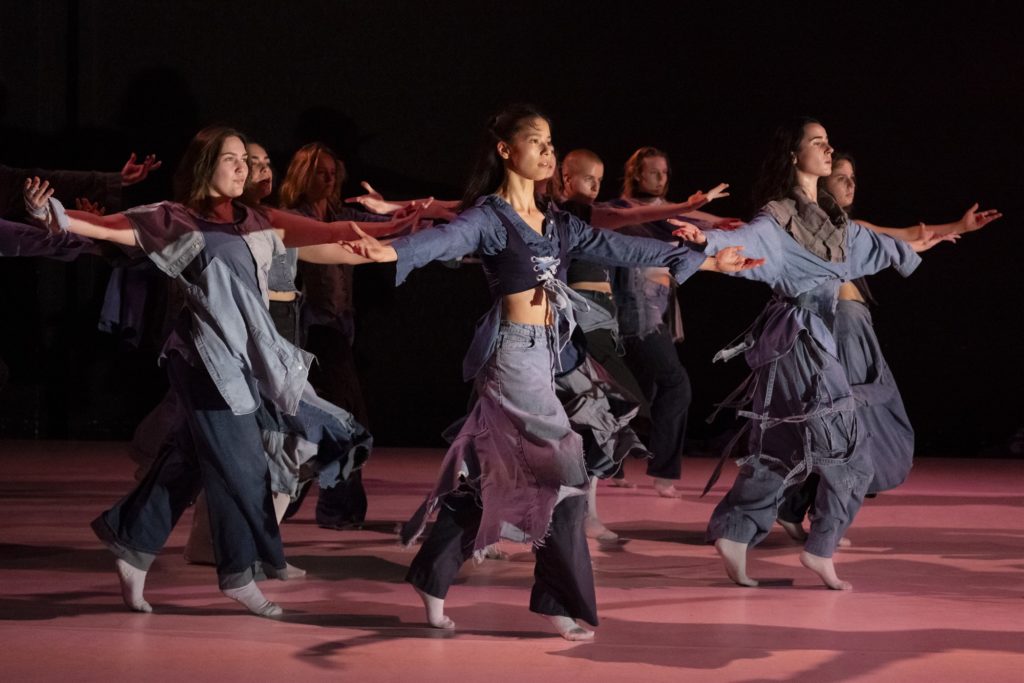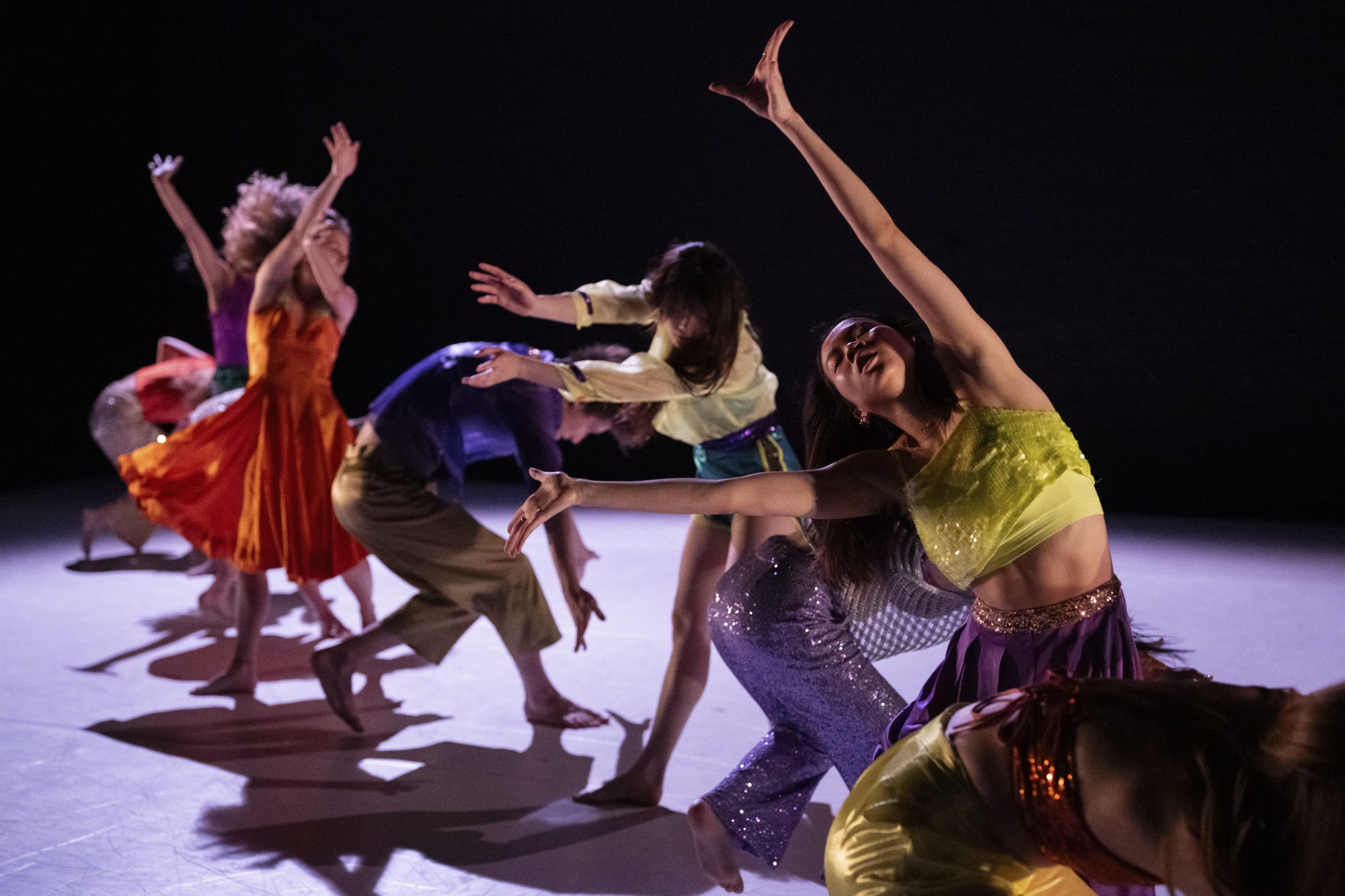Words by Stella Rousham.
Graduation shows come with a great pressure of compressing three years of learning into a single, polished performance, all stamped with a label of approval from an acclaimed dance company or choreographer. In this year’s collaboration with third-year students from London Contemporary Dance School, the four guest artists – SAY Dance, Simone Mousset, Holly Blakey and Sung Im Her – resisted the reductive tendencies inherent in the form of the ‘graduation show’. Through rapturous rhythms, comic characterisation and self-referential critique, the four distinct pieces were united in their collective ambitions to subvert antiquated structures of hierarchy and individualism. From re-staging a ‘pigeon dance’ and to balletic leaps constrained by dirty washing, this graduation show has left me with a genuine hope that the next generation of dancers will transform unequal relations and roles in the dance industry.
Kicking off the graduation show was As Is by SAY Dance (Sarah Golding & Yukiko Masui) – an uplifting, piece that empowered students to own the stage as their full, authentic selves. In a colourful marriage of music and movement, slick duets and punchy ensemble sequences were accompanied by the bassy tunes of hip-hop/rap artists: Mikey J Asante, Bobbie Johnson and B4mba. The baggy red and blue costumes (designed by Jacob Elliot Roberts) were the ideal companion to the martial-art like floorwork, creating the impression of a graphic novel.
From the second the music started, to the final blackout, As Is was energised by the sheer joy of moving as a collective, as each dancer poured their full self into every single roll, kick and head bop. In a noteworthy chair sequence, the seventeen strong company bounded through deep lunges, hair swishes and punches, defying restrictive norms over who can or cannot perform certain movements. The ability to create a unified company, whilst honouring individual expression, is testament to SAY Dance’s distinctively communal and celebratory approach to choreography.
Comic, camp and clever, Simone Mousset’s Summer Flight featured a spoofed restaging of the prestigious ‘Pigeon Dance’ to satirise the cult of individualism and male chauvinism within traditional dance institutions. Commencing with a video message from the scarf-swishing, ego-dripping M. Chevalier – fictionalised Artistic Director of the Ballet National Folklorique du Luxembourg – the dancers (dressed as pigeons in Matthew Bourne-esque furry culottes and brown morph suits) proceeded to perform this “fiendishly difficult” folk dance.
Impassioned facial expressions, complex floor-patterns, pigeon-inspired shuffles and arm-flaps; it was only when the performance descended into ironic speeches and acapella songs from the students – as they contemplated their future prospects as freelancers – that the farcical nature of this work became apparent. Attention to detail and absolute immersion in the fantasy of the Ballet National Folklorique du Luxembourg carried the piece; the programme notes even featured a link to a fake website and Instagram page for M. Chevalier. In a chaotic, hysterical mass, the work ended with the student performers crawling towards the audience, desperately crying out promises such as – “I will wash your dog” – in a final plea to gain M. Chevalier’s favour. Witty and insightful, Mousset’s piece highlights pertinent dilemmas of how artists can retain their values in an industry that increasingly demands that individuals sell themselves. What would the dance world be without celebrity, status and tradition?

In the third work of the evening, MONSTER PHRASES, choreographer Holly Blakey took aesthetics of the home and feminity to toy with the hierarchical distinction between art and domesticity. In the company of 12, each dancer initially navigated the stage through their own characterised motif as an ‘unruly monster’ – one adopting hyper-feminised, sassy saunters and hip swings, another trudging with their head bowed, a third flicking their heels and jumping repeatedly in a balletic-cowgirl style. Rigorous, furiously charged duets (including a particularly impressive moment where two dancers effortlessly pulled each other on and off the floor like a see-saw) harked to questions of power, rage and agency in familial and gendered relationships.
Layered, mismatched, colour-clashing costumes – denim shorts over red tracksuit bottoms, skirts over trousers – gave the piece an uncanny quality. Like clean washing becoming dirty, mundane gestures turning monstrous. A desperate attempt to forge agency in world of social norms and expectations. Doused in a Barbie pink wash, the climax of the work involved the 12 dancers charging down the stage in a compulsive motif of chest pops, heel flicks and turns, resembling a mythological Hydra. The final tableau featuring a dancer standing centre stage, entrapped in web made from clothes tied together remains imprinted in my mind. An image of frustration, disappointment and chaos: Is domesticity the counterpoint to glamour and thrill?
Shimmering like fruit-pastel sweets in orange, purple and green costumes, the dancers in Sung Im Her’s Stories of us but all at once, closed the evening in a mesmerising, poetic work exploring themes of growth, cycles and nature. A simple yet engrossing opening, as eleven dancers moved responsively to the audible breaths of a solo dancer at the centre of a circle, set the tone for this thoughtful, synesthetic work.
Staying true to Im Her’s methodology, the choreography focussed on pure, bodily derived movements that grew cumulatively in complexity through repeated articulation. Four dancers in a horizontal line swinging forwards and backwards, into and out of the floor, hair flying freely like a wave crashing on the shore. 11 dancers weaving in and out of one another in a diagonal line that swung across the stage, replicating the hands of clock.
Like pearl trapped in a shell, encased alongside these forceful ensemble sequences were moments of vulnerability and tenderness, such as a solo dancer repeatedly counting aloud – “1,2,3,4” – but not quite being able to complete or remember the rest of the phrase. Through her patience, care and fastidious attention to detail, Sung Im Her effectively captured the highly individualised, yet universal, peaks and troughs of human life.
Tackling broad but related themes of power, nature and identity, the real success of the four guest artists was the ability to mobilise their distinct choreographic style and method as means to celebrate, empower and nurture the students. The result; a graduation show that dispelled ego and hierarchy, conveying a powerful message that the dance industry is better when we work together.
